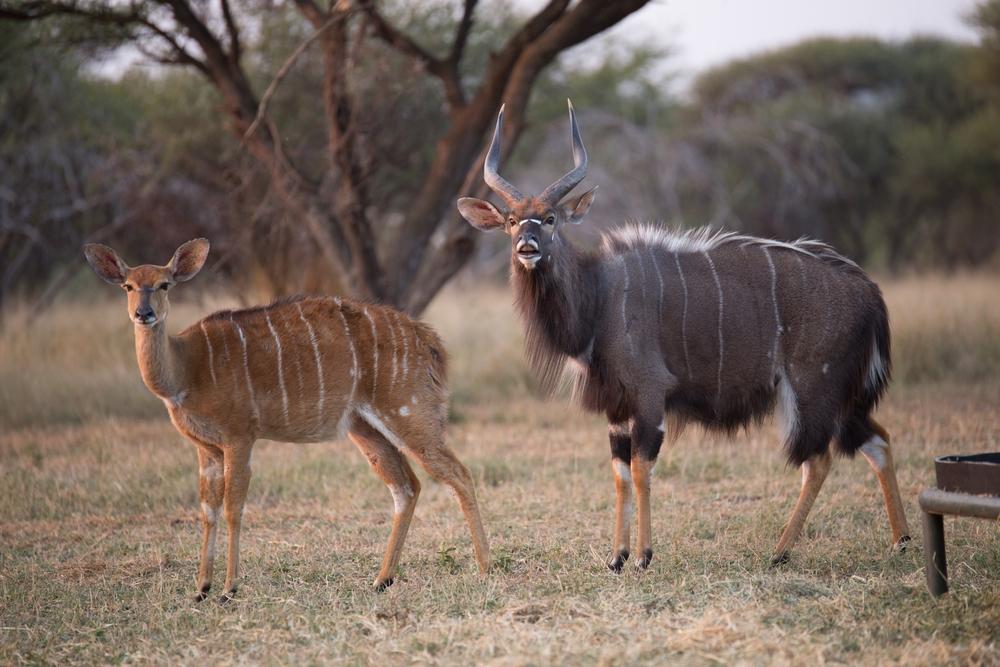Antelope South Africa hunting trophies include a large range of species from the enormous eland to the diminutive duiker, with many and varied game in between. But amongst those antelope, lies a group of special spiral-horned game, whose beauty make them sought-after game hunting trophies not only in South Africa, but worldwide.
World famous for their impressive spiral horns and their innate beauty, the kudu, bushbuck, eland, and nyala are both a challenge to hunt, and an immense reward for any game hunting enthusiast.
In this blog, we look at these South Africa hunting trophies, focusing on the spiral-horned antelope and what makes them so remarkable.
[DYNAMIC-BLOGTABLEOFCONTENT]
Key Takeaways
- South Africa is home to many and varied game hunting trophies, but the spiral-horned antelopes are something exceptional.
- While there are six spiral-horned antelope in Africa, only four are found in South Africa, with the sitatunga and the bongo being available to hunt in other African countries.
- South Africa hunting trophies that are spiral horned include the kudu, nyala, bushbuck, and eland.
- Each of these species offers the hunter a different challenge when targeting them.
- The kudu is known as Africa’s gray ghost and its ability to blend into its habitat makes it a challenge for hunters in search of this spiral-horned trophy.
- The nyala is renowned for its exceptional senses, as well as its shy and elusive nature.
- The eland, although the largest of the spiral-horned antelope and the largest antelope species in Africa, is a skittish and shy species, requiring patience and persistence from hunters wanting to add this big game antelope to their trophy room.
- The bushbuck is a smallish antelope, known for its elusive nature, and its aggression should it be wounded, so expert shot placement is required when targeting this spiral-horned antelope.
- South Africa, and some neighboring countries, offer a hunt known as the “Spiral Horn Slam” that sees all four spiral-horned antelope targeting in a specific number of days.
- Completing this hunt successfully gives the hunter bragging rights, as well as some exceptional South Africa hunting trophies to add to his collection.
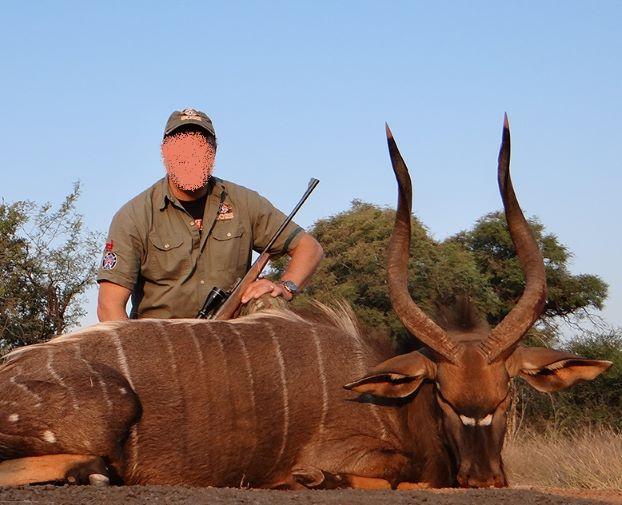
South Africa’s Famous Spiral Horned Antelopes
When hunting in South Africa, many hunters choose to hunt the famous Big 5 or Dangerous 7, but the idea of targeting a specific antelope type, like the spiral-horned antelope, provides the hunting party with a different, yet rewarding hunting experience.
While there are six main spiral horned antelope found in Africa, only four of the six are found in South Africa, with the sitatunga found in southern and central Africa, and the bongo inhabiting west Africa.
South Africa’s spiral-horned antelope include:
- Kudu: An iconic species when hunting in South Africa
- Nyala: A beautiful antelope, closely related to the kudu
- Eland: South Africa’s largest antelope and largest spiral horned antelope
- Bushbuck: Arguably one of Africa’s shyest and most elusive antelope to hunt
The Kudu
Often referred to as “Africa’s gray ghost” the kudu is king of the spiral-horned antelope. This shy and elusive antelope is a challenge to hunt, as it seamlessly disappears into its environment. This camouflage skillset allows it to quickly disappear and hide from both predators and hunting parties!
The greater kudu (Tragelaphus strepsiceros) is one of South Africa’s most iconic species, and one that many hunters choose to target year upon year as they return to enjoy hunting in South Africa.
This majestic and striking antelope stands close to 5 foot at the shoulder, weighing around 420- 595 pounds. Only the males of the species have beautiful long, spiral-shaped horns that twist two to three full twists and can reach up to 6 feet.
Kudu hunting in South Africa can be enjoyed in numerous provinces within the country, with each providing a unique experience of differing landscapes, habitats, and conditions. Some popular locations include the Eastern Cape, Limpopo, KwaZulu-Natal, as well as the Mpumalanga province.
The greater kudu is listed as a species of “least concern” by the International Union for Conservation and Nature (IUCN). Kudu hunting in South Africa is available throughout the year in many designated hunting concessions, allowing hunters to easily choose when it best suits them to target this magnificent antelope.
The best time for hunting these iconic South Africa hunting trophies is during the rutting season that runs from April to June and September to October when the bushveld is less dense, less growth and allows for the prey to easily be spotted – if that is possible with this elusive antelope!
Hunting the kudu requires remarkable patience, perseverance and exceptional tracking, with a reminder of how effortlessly blend into their surroundings.
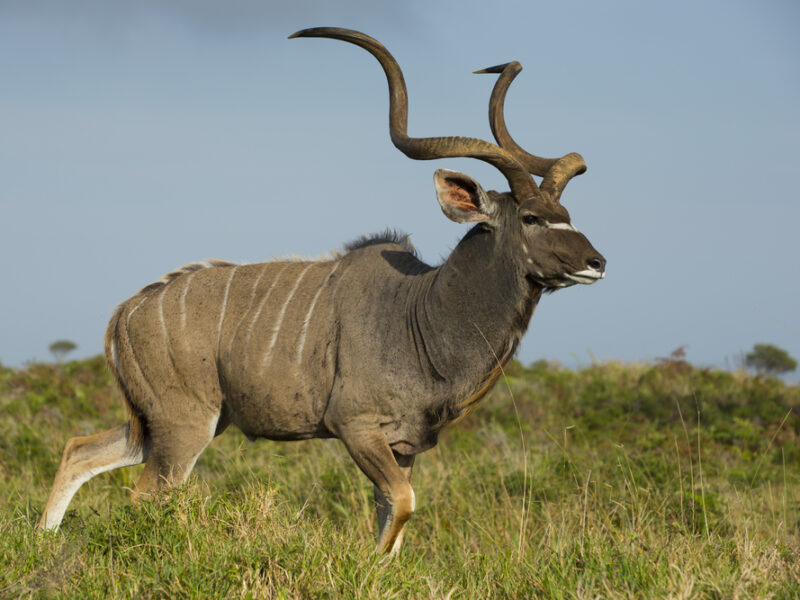
The Nyala
When it comes to striking African plains game antelope, the common nyala (Tragelaphus angasii) was front of the queue! It truly is a good-looking antelope, with the males of the species boasting magnificent spiral horns and unique markings that set them apart.
This sought-after antelopes species is native to southern Africa and are a challenge to hunt due to their shy, elusive natures, as well as their exceptional senses and alertness.
The male common nyala is a medium-sized antelope standing 43 inches at the shoulder and weighs 216-276 pounds. Their coat is grey to brown color and the male’s coat is shaggy, with a bushy tail measuring 7-10 inches in length. It has two to five abstract stripes stretching from the back to the belly, and 6–10 white dots found alongside these markings. Similar patches and markings in white adorn the face, throat, and legs. Only the males have spiral-shaped, yellow-tipped horns that reach 24-33 inches in length.
Hunters interested in nyala hunting in South Africa are spoilt for choice, with the animal being abundant in many regions throughout the country. The antelope’s chosen habitat of dense bushveld and woodlands close by to a water source ensures that top locations throughout the country include the Limpopo province (renowned for the largest and best quality nyala worldwide), Eastern Cape, KwaZulu-Natal, and Mpumalanga.
Common hunting techniques used to target what is seen as one of the most elusive antelopes worldwide often includes the spot and stalk technique, as well as ambushing the herd as they drink at watering holes. In terms of timing, the best time of day to hunt the nyala is early morning or late afternoon, when they are more likely to be active and out feeding. A reminder to approach them quietly, as they are an extremely shy species.
The IUCN status of these South Africa hunting trophies is “least concern.”
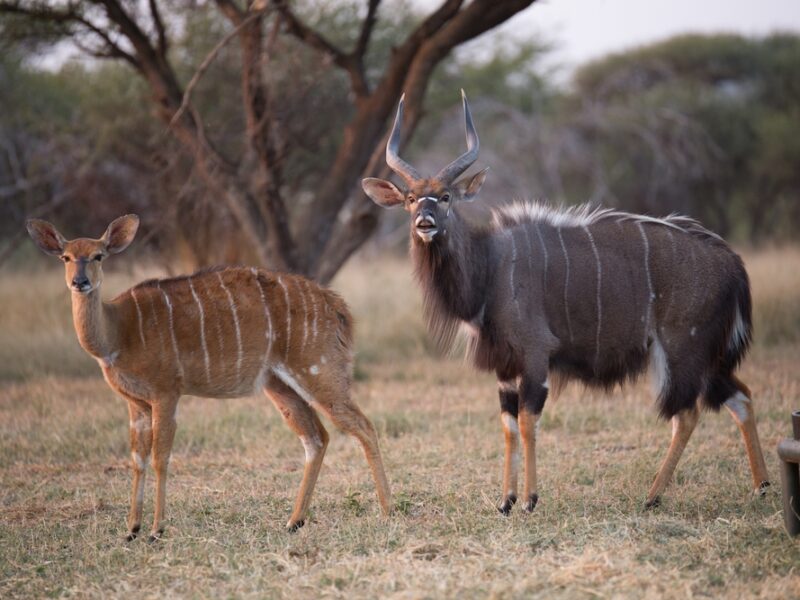
The Eland
As the largest spiral-horned antelope, and Africa’s largest antelope, the common eland (Taurotragus oryx) can weigh up to 2,000 pounds. This enormous antelope is known for its impressive size and strength, with its IUCN status listed as that of “least concern.”
Both male and female eland have horns, and this antelope’s horns size averages between 30-36 inches and are long and twisted. While this is the average horn size, it must be noted that there are some enormous eland South Africa hunting trophies that are a great deal larger.
Eland prefer habitats that include grasslands, open woodlands and savannas, which in turn results in the top hunting locations for this exceptional African plains game species being the Limpopo province, Mpumalanga, and the Eastern Cape.
When it comes to hunting methods and techniques to hunt the eland, some popular options include spot and stalk, walk and stalk, hunting from a blind, ambushing at a water source, as well as tracking this antelope using expert trackers. Don’t be fooled though, hunting this antelope calls for a great deal of patience and perseverance, as it is extremely shy and very skittish. Add to this their good eyesight and hearing, and you have a great hunting adversary on your hands! A reminder to ensure that your shot placement on this massive antelope is spot on.
Eland hunting in South Africa is available throughout the year. However, the best time for eland hunting in South Africa is from June to October, during the cooler months, as well as when they are more visible.
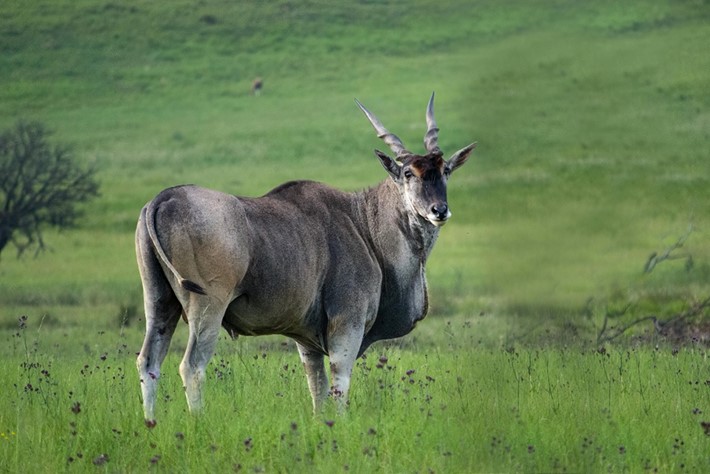
The Bushbuck
The Bushbuck (Tragelaphus scriptus) is a tiny but striking member of the spiral-horned antelope family, known for its elusive nature and adaptability to various habitats found within South Africa. Their preferred habitats of dense forests and thickets allows them to practice this mysterious behavior and assists them in blending into their environment to evade predators.
These small antelopes weight around 88-139 pounds, with only males having horns. Their spiral-shaped horns range in length from 10-18 inches and are thick and hardy.
With a preferred habitat of dense bush, it is only natural that popular hunting safaris in South Africa tick the boxes in terms of this environment. They include the Limpopo province, Eastern Cape, Mpumalanga, and KwaZulu-Natal.
With bushbuck being more active in the early mornings and late afternoons, hunting during this time will increase your chances of harvesting your bushbuck South Africa hunting trophies.
Hunting methods and techniques used to target the bushbuck include the spot and stalk option, or using the ambush method near water sources. Keep quite quiet, with your eyes peeled, as these shy antelopes will seemingly suddenly appear, with their quiet approach not heard or noted.
These antelope may be quite diminutive but can also become quite aggressive when wounded. Ensure that your shot placement is spot on to ensure a humane and quick death for the animal.
The IUCN status of these South Africa hunting trophies is “least concern.”
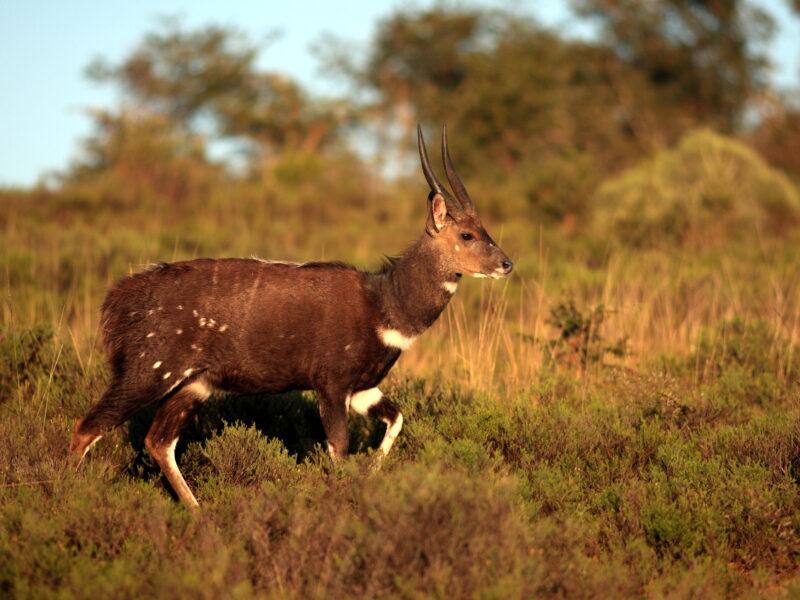
The Famous Spiral Horn Slam
These South Africa hunting trophies just got a bit more sought-after, with the exciting Spiral Horn Slam hunting safari that is offered by many African outfitters, to challenge game hunting enthusiasts and provide a special hunting experience.
What is the Spiral Horn Slam?
The Spiral Horn Slam is a prestigious game hunting challenge aimed at successfully hunting four spiral-horned antelope. These antelope, namely the kudu, bushbuck, eland and nyala, need to be hunted over a specific number of days (usually 7-10 days). This hunt is available in South Africa, but Namibia and Zimbabwe are also able to offer this exciting hunting challenge.
Why is this a Sought-After Achievement?
This Spiral Horn Slam is available to complete as a hunting safari in South Africa, and challenges hunters to push themselves not only in terms of time, but also in terms of species, with each chosen species presenting the hunting party with different challenges and unique hunting scenarios.
Successfully completing this slam also gives the hunter bragging rights, and a set of extremely remarkable South Africa hunting trophies to add to their trophy room!
While the main region for the Spiral Horn Slam is South Africa, neighboring countries such as Namibia and Zimbabwe can also offer these hunts.
Frequently Asked Questions
Where is the best hunting in South Africa?
While South Africa is known as the pinnacle of hunting on the African continent, its Limpopo province is renowned as the best location to enjoy a game hunting safari and is home to some of the best hunting grounds in South Africa, if not Africa.
What time of the year is best time for a hunting safari in South Africa?
The cooler winter months of May – August provide hunters with great weather to enjoy when hunting in South Africa. South African winters generally refer to mild day with colder mornings and evenings.
Can kudu antelopes jump?
Kudu are known for their exceptional jumping abilities and can clear an 8-foot fence with ease.
Is hunting big in South Africa?
Yes, hunting is indeed popular in South Africa, with local hunters engaging both in meat and trophy hunting activities.
What species are popular game to hunt in South Africa?
Popular game hunting species in South Africa include the kudu, warthog, impala, springbok, wildebeest, and zebra. South Africa offers a wide range of game hunting species, from the Big 5 and Dangerous 7 to specialty game, African plains game and African cats, with hunters spoilt for choice in terms of targeted species as well as locations.
What is the most hunted animal in South Africa?
The most hunted animal in South Africa is the famous gray ghost, the kudu. The kudu, also known as king of the spiral-horned antelopes, is hunted for both its beautiful horns, as well as meat. Completing the top three of the most hunted animals in South Africa is the Cape buffalo and the nyala.
Conclusion
South Africa hunting trophies can vary greatly from the iconic springbok or perhaps some members of the Big 5, to the remarkable and unusual spiral-horned antelope of the region, it all depends on the hunter. But if you are wanting an incredible and challenging hunting safari in South Africa, combined with exceptional rewards when successfully harvesting these antelopes, look no further than the kudu, eland, bushbuck, and nyala.
Hunting these spiral-horned antelopes, together with the varying landscapes, conditions and individual species make it an unforgettable hunting safari in South Africa, with tales of thrilling hunts and rewarding experiences.
Author: B. Hershensohnn
